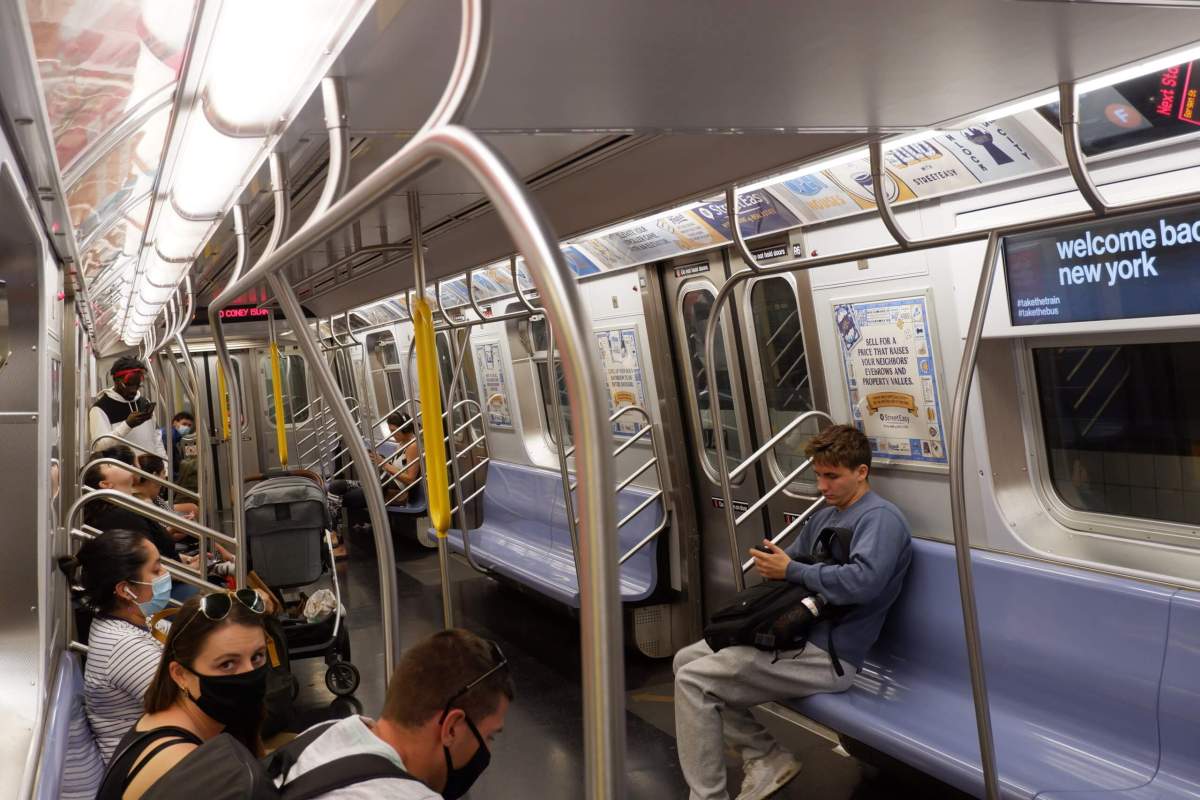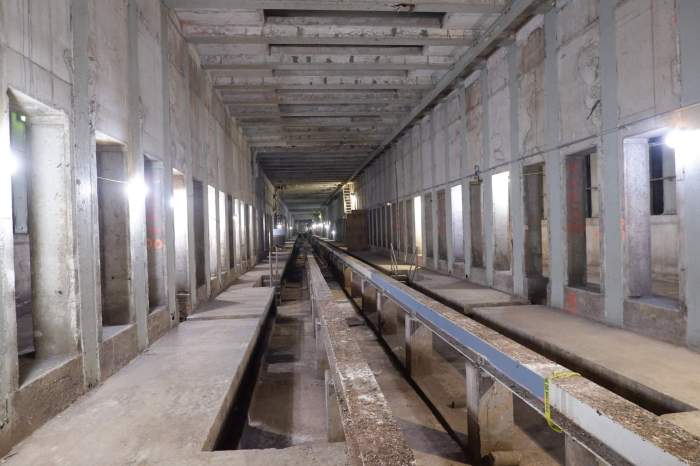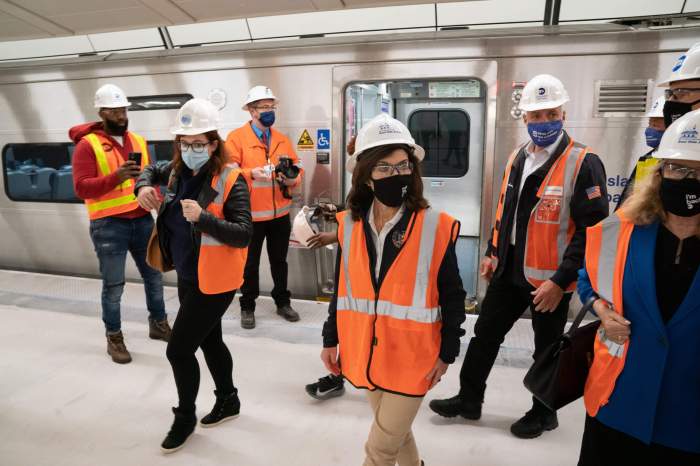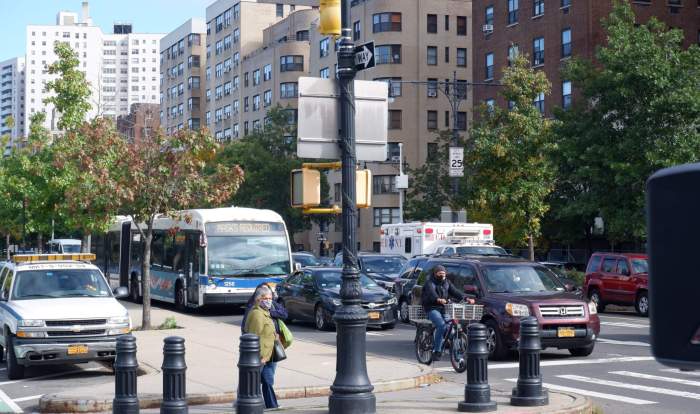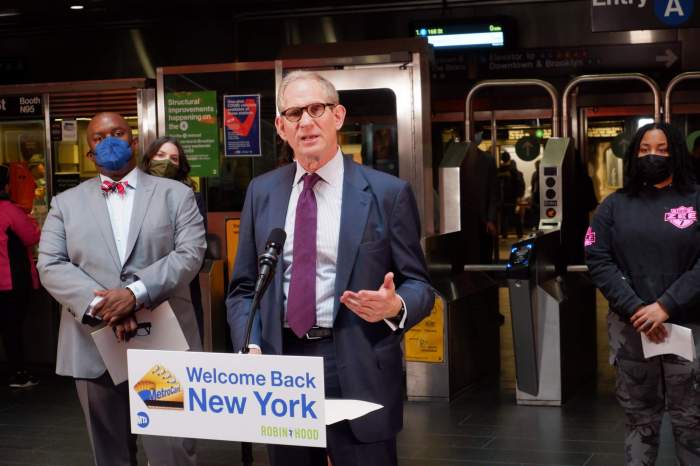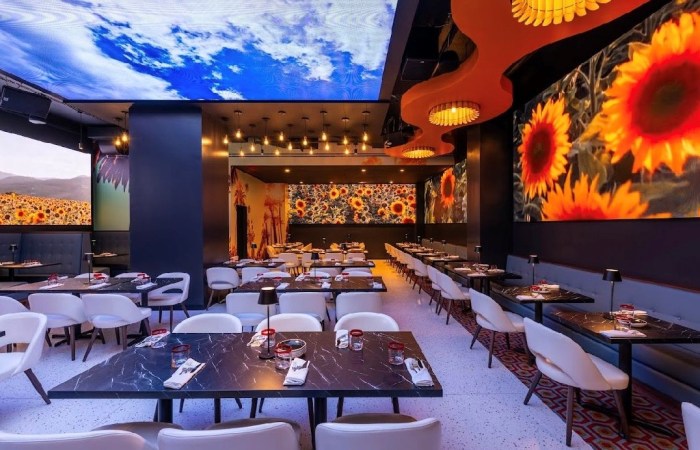This is a New York City-bound CCTV train.
Governor Kathy Hochul wants to equip every subway car in the Big Apple with a pair of surveillance cameras, she announced Tuesday.
The $5.5 million effort, partially paid for by the federal government, will add nearly 13,000 cams over two years, and Hochul hopes the watchful eyes will make straphangers feel safer.
“You think Big Brother’s watching you on the subways? You’re absolutely right,” the governor said at a press conference at a subway maintenance facility in Corona, Queens, Sept. 20.
“That is our intent, to get the message out that we’re going to be having surveillance of activities on the subway trains, and that is going to give people great peace of mind,” Hochul added. ”If you’re concerned about this, the best answer is don’t commit any crimes on the subways — then you won’t have any problems.”
The Metropolitan Transportation Authority will install the 12,710 new cameras on 6,355 subway cars over the next 18-24 months, wrapping up the project sometime in 2025.
The agency began testing 200 cameras on 100 cars in June on the Nos. 2, 4, 5, and 6 lines, along with B, F, G, and M trains, according to New York City Transit’s Vice President for the Department of Subways Demetrius Crichlow.
The MTA already has more than 10,000 machines across its 472 subway stations.
A batch of new R211 subway car models on order will come already equipped with the cameras when they start rolling into service early next year.
Here’s a sample of surveillance footage with MTA chief Lieber, subways chief Demetrius Crichlow, and Gov Hochul on a train pic.twitter.com/qNsi474P7h
— Kevin Duggan (@kduggan16) September 20, 2022
The state-controlled Authority will foot $3.5 million of the bill, while a $2 million grant from the U.S. Department of Homeland Security will cover the remaining cost.
The dollars from Washington will also pay for 3,800 more cameras at 130 subway stations.
“If you prey on New Yorkers or you commit vandalism or damage MTA facilities, we’re going to have pictures of you, and the NYPD is going to find you, gonna catch you, and gonna punish you,” MTA Chairperson and CEO Janno Lieber said.
Despite the MTA’s vast network of existing cameras, the agency infamously lost its feed when a gunman opened fire at a subway station in Sunset Park earlier this year, but Lieber said he was confident in the system.
“We’re doing more and more predictive maintenance. That means you don’t wait for stuff to break,” the transit big said. “You develop the technology and the data so that you know when you have to fix something and when it starts to malfunction.”
“It’s like the equivalent of a check engine light, so we’re doing that all over the bus and subway system, so I have a high level of confidence,” Lieber added.
The announcement drew criticism from privacy advocates, who slammed Hochul for deploying more surveillance infrastructure.
“Big brother’s spying never prevented crime before, and it won’t start now. This tech has failed us too many times to count,” said Albert Fox Cahn, the executive director of the group the Surveillance Technology Oversight Project. “This surveillance theater won’t just put New Yorkers at risk, it’s ripe for abuse by the NYPD. We deserve better than digital stop and risk.
“I’m deeply disappointed that Hochul put New York on an express train to authoritarianism,” he said.
Hochul countered those concerns saying that New Yorkers are already being recorded all over the Big Apple anyway.
“Security cameras have been a way of life,” she said. “You walk into any grocery store and you’re being watched, you walk into the drugstore you’re being watched, you walk in the airport you’re being watched.”
Transit leaders and police brass touted a slight decrease in crimes this year compared to pre-pandemic numbers, with NYPD logging 1,618 major felonies so far in 2022 as of Sept. 18, compared to 1,696 for the same time in 2019, a decrease of 4.5%.
However, daily ridership has remained down by about 40% compared to three years ago, and police stats show that crime is actually up over the last two years.
The current numbers are largely flat going back at least to 2014, excluding the first two pandemic years, according to longer-term trends NYPD leaders showed MTA board members at a Monday meeting.
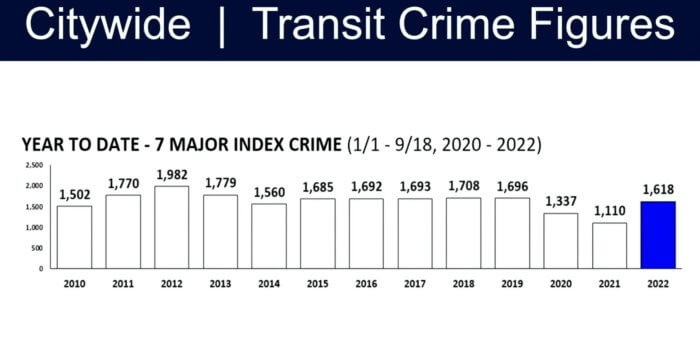
Overall, transit accounts for a mere 1.8% of the city’s overall crime, but riders continue to list personal safety as a top concern, according to a June MTA rider survey released Monday.
Lieber last month said that the main driver keeping daily trip numbers lower is office workers staying remote, and weekend rates have returned much faster than Monday to Friday.
Lisa Daglian, the executive director of the MTA’s in-house rider advocacy arm the Permanent Citizens Advisory Committee, said the new tech will help bridge the gap between perception and reality.
“Having more tools in the toolbox to bring people’s perception closer to the reality that subways are not a danger as a lot of people make them out to be is going to help people get back on board,” said Daglian. “The safer people feel, the more likely they are to ride.”
Some riders agreed, saying that personal security outweighed privacy concerns.
“I think it’s a good idea,” said Jason Ghiassian as he waited for a No. 7 train at 42nd Street. “Safety comes first.”
“I’m good with it,” said another 7 train rider, who gave her name as Sue. “I don’t [worry about privacy concerns] because safety is more important to me.”
One commuter, however, doubted that the machines would do much to make commutes safer.
“It doesn’t make any change,” said Ray Carlo. “How long ’til NYPD shows up? Cameras don’t stop a murder, right?”
“You wouldn’t feel more safe,” he added, pointing at cameras watching the Midtown station’s platform.



